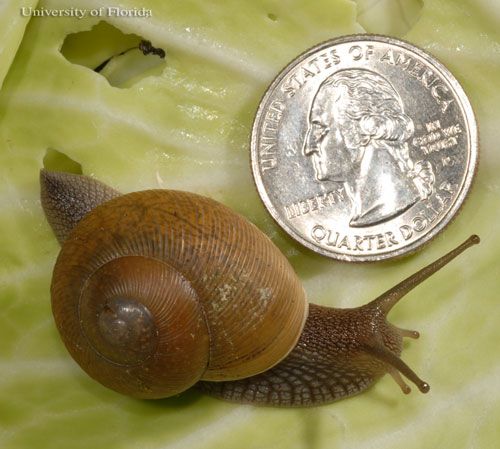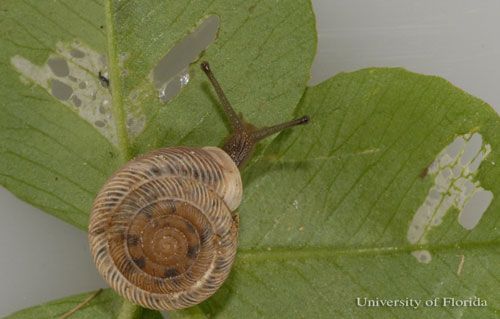Look Out For These Florida Terrestrial Snails
Their helical shells, tentacle-like eyes, and slimy muscular bodies are all highly distinguishable features that make snails easy to recognize. Florida is home to a variety of native and non-native snails — most of which are harmless. However, there are a few Florida terrestrial snails that can wreak havoc on gardens, lawns, and crops. This makes it important to separate beneficial snails from potential pests.
The Featured Creatures publication, “Terrestrial Snails (Phylum Mollusca, Class Gastropoda) Affecting Plants in Florida,” contains thorough details on identifying these slimy pests. This publication, complete with detailed observations and photographs, can help you put a name to some common Florida snails.
Cuban brown snail
Found In South Florida, Tampa, and Orlando
On average, this snail is about the size of a quarter and is notorious for its insatiable appetite. Watch out — the Cuban brown snail will devour anything in its path, whether it’s tropical plants, citrus trees, or vegetables!

Asian tramp snail
Found In South Florida and Tampa
If you enjoy snacking on citrus, mango, or grapes, beware of the Asian tramp snail — it also enjoys these foods!
While the Cuban brown snail is about the size of a quarter, the Asian tramp snail is closer in size to a dime. However, this does not mean that they cause any less environmental destruction!
Giant ramshorn snail
Found In South Florida
Picture a ram sheep in your mind. Imagine their large, circular horns protruding over their head.
The shell of a giant ramshorn snail looks pretty similar!
Unlike some of the other terrestrial snails on this list, a giant ramshorn snail is quite omnivorous. They often feed on aquatic plants and animals.
Milk snail
Found In Tampa and Amelia Island
Care for a snail to go with your glass of milk? Milk snails are edible!
In Florida, milk snails are known to cause only minor damage.
Jumping snail
Found In Northeast and South Florida
Have you ever jumped slightly when something spooked you? Jumping snails can relate. These snails can leap when they are disturbed!
While jumping snails prefer to munch on orchids, they are also known to feed on avocado and mango, making them destructive to these fruit crops.
Southern flatcoil snail
Found In Peninsular Florida
You may not consider snails to be skilled climbers, but Southern flatcoil snails have proven differently. Southern flatcoil snails can climb garden fences, trellises, and vegetation.
These snails are also stunning in appearance. Their shells mimic the look of a coiled lasso or rope!

White-lip globe snail
Found In Northeast Florida
The white-lip globe snail is not fussy with where it calls home. These snails can occupy a range of habitats, including woods, meadows, marshes, gardens, and roadsides.
Nevertheless, one feature of these snails remains consistent — they love hiding in leaf litter! When not hiding, white-lip globe snails can be found eating fungus, wild foliage, and garden plants.
Perforate dome snail
Found In North Florida
Perforate dome snails are one of three types of dome snails in northern Florida. The other two — the wax dome and the Seminole dome snail — do not pose a threat to gardens or crops.
While perforate dome snails are small, they can still eat a sizable number of leaves, flowers, and annual garden plants. They will travel long distances for their meals, often preferring to conduct their travels during rainy Florida evenings.
Giant African land snail
Found In South Florida
Out of all the snails on this list, these snails are arguably the most devastating. Not only do giant African land snails consume hundreds of different plants from across the world — they also transmit multiple disease-causing organisms to plants, animals, and humans.

If you ever stumble across these snails, you should always handle them with gloves.
For more information on snails, terrestrial or otherwise, visit Ask IFAS to stay up to date!
 1
1
